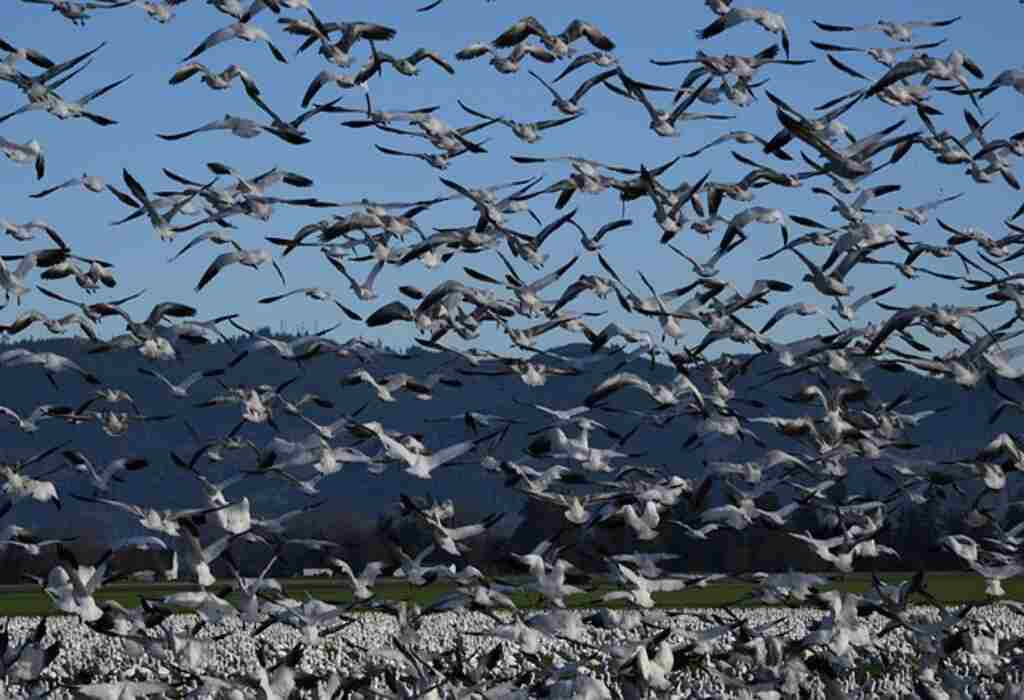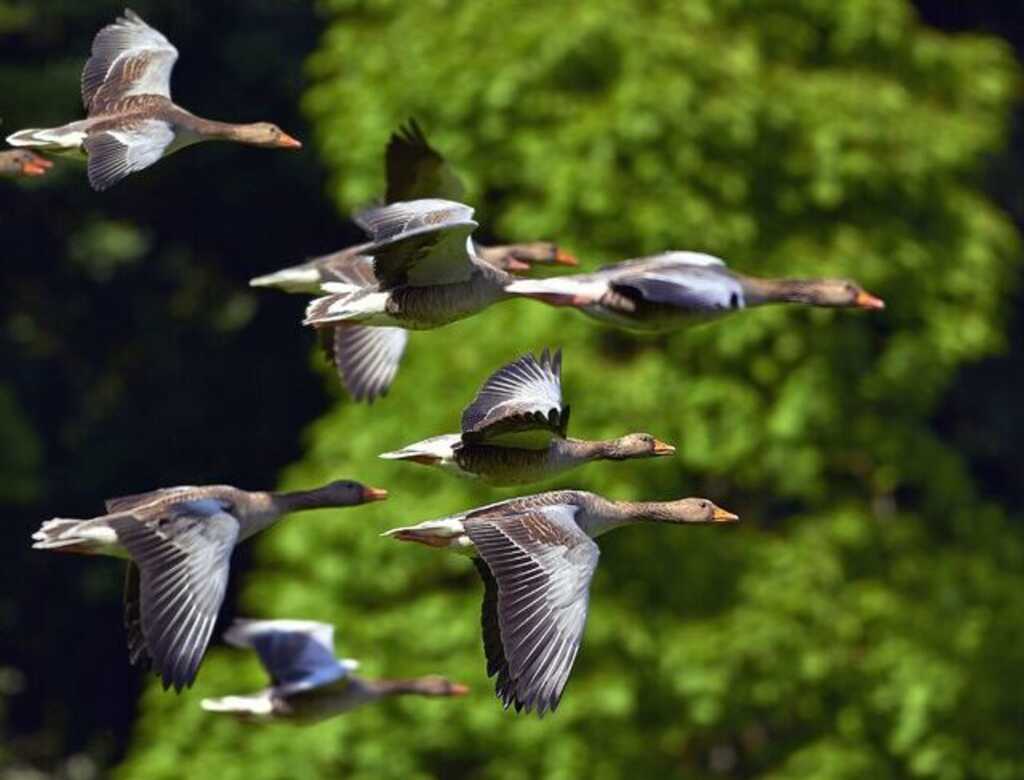Climate change is one of the biggest global challenges of our time, and it is having profound impacts on ecosystems worldwide. One of the most visible effects of climate change is its impact on the migration patterns of birds.
The United States is home to a diverse array of bird species, many of which rely on predictable seasonal patterns to breed, feed, and survive. As climate change disrupts these patterns, it threatens the survival of bird populations and the ecosystems they support.
Understanding the complex interactions between climate change and bird migration is crucial for conservation efforts and policy decisions.
By studying the mechanisms behind these changes, scientists can better predict the effects of future climate scenarios and develop effective strategies for mitigating their impacts on bird populations and their habitats.
Table of Contents
- 1 Key Takeaways:
- 2 How Does Climate Change Affect Birds
- 3 Understanding Bird Migration Patterns
- 4 Impacts of Climate Change on Bird Migration
- 5 Shifts in Bird Behavior
- 6 Ecosystem Impacts
- 7 Conservation Efforts and Challenges
- 8 Case Studies: Birds and Climate Change
- 9 Monitoring and Research
- 10 Climate Change Mitigation and Adaptation Strategies
- 11 Citizen Science and Public Engagement
- 12 Policy Implications
- 13 Funding and Resources
- 14 Conclusion
- 15 FAQs: How Climate Change Is Affecting The Migration of Birds?
- 15.1 How is climate change affecting the migration of birds in the United States?
- 15.2 What are the factors that influence bird migration patterns?
- 15.3 What are the impacts of climate change on bird migration?
- 15.4 How are birds adapting to climate change?
- 15.5 How does climate change impact ecosystems?
- 15.6 What are the conservation efforts and challenges associated with climate change and bird migration?
- 15.7 Can you provide case studies of birds and climate change?
- 15.8 What is being done in terms of monitoring and research?
- 15.9 What are the strategies for mitigating and adapting to climate change?
- 15.10 What is the role of citizen science and public engagement in bird migration and climate change?
- 15.11 What are the policy implications of climate change on bird migration?
- 15.12 What funding and resources are available for research and conservation efforts?
- 16 Author
Key Takeaways:
- Climate change is disrupting the migration patterns of birds in the United States, which can have profound impacts on ecosystems and the survival of bird populations.
- It is important to understand the mechanisms behind these changes in order to develop effective conservation strategies and policy decisions.
- Studying the impacts of climate change on bird migration can help scientists better predict the effects of future climate scenarios and identify ways to mitigate their impacts on bird populations and their habitats.
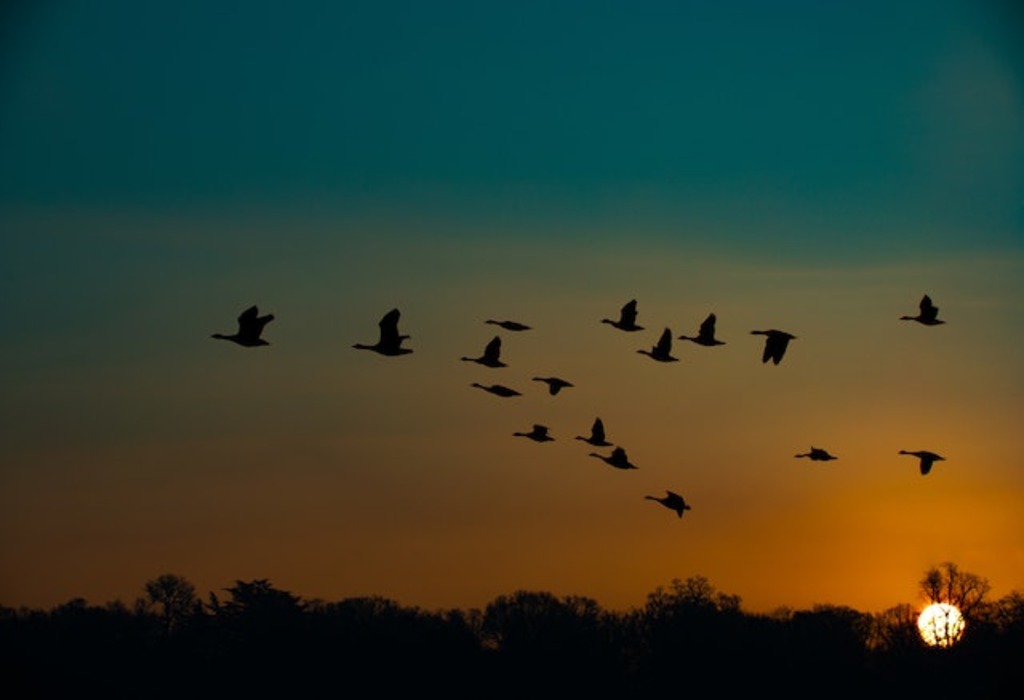
How Does Climate Change Affect Birds
Climate change is having a significant impact on the migration patterns of birds. As temperatures warm and weather patterns shift, many bird species are altering their migration routes, timing, and destinations.
Some birds are shifting their migration routes in response to changing weather patterns and habitat availability, while others are adjusting their migration timing to match changing environmental conditions.
Additionally, some bird species are shifting their wintering grounds or range limits in response to changing climate conditions.
Despite the challenges posed by climate change, many bird species are showing remarkable resilience and adaptability.
To help protect birds and their habitats, it is important to support conservation efforts, reduce your carbon footprint, and create bird-friendly habitats.
Understanding Bird Migration Patterns
Bird migration is a complex and fascinating phenomenon that has captured the attention of scientists and nature enthusiasts alike. Migration patterns are shaped by a variety of factors, including genetics, environment, and climate.
In recent years, the impacts of climate change on bird migration patterns have become an increasingly important area of study.
What Are Bird Migration Patterns?
Bird migration patterns are the seasonal movements of birds from one location to another. These movements may be relatively short, such as within a single forest, or may span thousands of miles, crossing entire continents or even oceans.
Migration patterns are influenced by a variety of factors, including food availability, breeding habitat, and climate.
The timing of migration is often tied to seasonal changes in temperature and food availability.
In the spring, birds migrate north to take advantage of newly available food and breeding habitat, while in the fall, they move south to avoid winter weather and scarcity of food.
Factors Affecting Bird Migration in a Changing Climate
Climate change can disrupt bird migration patterns by altering the timing and availability of key resources. For example, rising temperatures may cause plants to bloom earlier than usual, which in turn may cause insect populations to peak before birds arrive.
As a result, birds that rely on these insects for food may experience reduced survival rates or may arrive at their breeding grounds too late to successfully reproduce.
Changes in weather patterns can also impact bird migration, particularly for long-distance migrants that rely on favorable winds for efficient travel.
Extreme weather events, such as storms or droughts, can cause delays or detours in migration routes, further complicating the journey for birds.
In addition to these direct impacts, climate change may also alter the availability and quality of breeding and wintering habitats for birds, which can have cascading effects on entire ecosystems.

Impacts of Climate Change on Bird Migration
Climate change is having a significant impact on bird migration patterns across the United States. As temperatures rise and weather patterns become more unpredictable, birds are experiencing a range of challenges that are disrupting their natural migration behaviors.
Changes in Timing: One of the most significant impacts of climate change on bird migration is that it is altering the timing of their movements. As temperatures warm, some species are migrating earlier in the year, while others are delaying their migration due to extended periods of warm weather. These changes can disrupt the timing of breeding and nesting, leading to a range of consequences.
Changes in Routes: Climate change is also affecting the routes that birds take during migration. Changes in wind patterns and food availability are influencing where birds stop to feed and rest during their journey. This can lead to birds traveling longer distances or taking less direct routes, which can impact their survival rates and overall health.
Changes in Food Availability: Changes in temperature and weather patterns are also affecting the availability of food for migrating birds. For example, some species rely on specific types of insects or plants for food during their migration, and changes in weather can disrupt these food sources. This can lead to birds arriving at their destination in poor health or struggling to survive.
Changes in Habitat: Climate change is also altering the habitats that birds rely on during migration. For example, changes in temperature and precipitation can affect the availability of suitable nesting and breeding sites. This can lead to declines in bird populations and disruptions to ecosystems.
The impacts of climate change on bird migration are complex and wide-ranging. As a result, it is crucial to develop effective conservation strategies that address these challenges and protect bird populations in the face of a changing climate.
Shifts in Bird Behavior
Due to climate change, birds are exhibiting changes in their behavior as a way to adapt to their changing environment. Some species are altering their migration routes, while others are changing their breeding patterns or adjusting their feeding behaviors.
For example, many bird species are migrating earlier in the spring in response to warmer temperatures. This change in timing allows them to take advantage of the earlier emergence of insects and the earlier blooming of plants.
Other species are shortening their migration routes or shifting their ranges northward as habitats become less suitable or shift in response to climate change.
In addition to these changes in migration patterns, birds are also changing their breeding behaviors. Some species are shifting their breeding season earlier in response to the earlier onset of spring, while others are changing the timing of their egg-laying to coincide with the peak availability of food.
Finally, birds are also adjusting their feeding behaviors in response to climate change. For example, some songbirds are changing the types of insects they feed on, while other species are shifting their diets to include more plant material or alternative food sources.
These changes in behavior are critical for the survival of bird populations in the face of climate change. By adapting to their changing environment, birds are increasing their chances of finding suitable habitats, food, and mating opportunities.
Ecosystem Impacts
Climate change is not only affecting bird migration patterns, but it is also altering ecosystems in which they live. As bird populations move to adjust to new climate patterns, they have the potential to disrupt important ecological interactions such as pollination and seed dispersal.
These impacts can have cascading effects on other species and the overall functioning of ecosystems, which can have implications for ecosystem services that humans rely on.
One example of ecosystem impact occurred in the Arctic, where snow geese overgrazed the tundra, causing changes in vegetation and soil composition that led to a decline in other species that live within the ecosystem.
Climate-induced shifts in bird migration patterns are also affecting the timing and distribution of species, which can result in mismatches between birds and the availability of resources such as prey or nesting sites.
Research has shown that many migratory bird populations that breed in North America are declining, and these declines are likely influenced by changes in climate patterns. These impacts are particularly severe for migratory birds that depend on specific habitats such as wetlands or high-elevation forests.
Furthermore, climate change is causing range shifts in some species, leading to the creation of new communities where non-native species may become dominant.
Overall, the impacts of climate change on bird migration patterns are complex, and the resulting changes in ecosystems are difficult to predict. However, it is clear that these impacts are likely to have cascading effects on other species, and the overall functioning of ecosystems.
Further research is needed to develop a comprehensive understanding of the ecological impacts of climate change on bird migration patterns and to develop strategies for mitigating these impacts.
Conservation Efforts and Challenges
The impacts of climate change on bird migration are of significant concern to conservationists who seek to protect these vulnerable species and their habitats. However, adapting conservation efforts to address the effects of climate change poses significant challenges.
One critical challenge is the uncertainty of how bird populations will respond to shifting migration patterns and altered habitats. Scientists and conservationists must work together to monitor and track bird populations to gain a better understanding of how they are being impacted by climate change.
Conservation Challenges
Climate change adds complexity to existing conservation challenges, such as habitat loss and fragmentation, invasive species, and human disturbance. Conservation efforts must also address the impacts of climate change, such as changes in weather patterns, droughts, and flooding.
Conservation strategies must be integrated across multiple landscapes and involve diverse stakeholders, including landowners, government agencies, and conservation organizations. These efforts may require significant investments of time, resources, and funding to effectively address bird migration impacts.
Adapting Conservation Strategies
Conservationists are adapting their strategies to address the effects of climate change on bird migration. One approach is to restore and create habitats that support bird populations as they adapt to changing climates.
Conservationists are also identifying and protecting critical habitats for bird populations, such as stopover sites and breeding areas. These actions can help mitigate the impacts of climate change and ensure the long-term survival of bird populations.
International Collaboration
The impacts of climate change on bird migration are a global issue requiring international collaboration. Countries must work together to develop policies and strategies that address the unique challenges faced by bird populations in different regions of the world.
Conservationists must also prioritize international partnerships to support research, monitoring, and conservation efforts. These efforts can help to develop effective management strategies and ensure the long-term survival of bird populations on a global scale.
Case Studies: Birds and Climate Change
Various bird species in the United States are experiencing the impacts of climate change on their migration patterns and behaviors. The following case studies highlight some of the specific ways in which different bird populations are being affected:
Shorebirds:
Shorebirds that breed in the Arctic are arriving at their breeding grounds too late to take full advantage of the short Arctic summer. This is due to warmer temperatures causing earlier snowmelt and plant growth, which in turn leads to an increase in insect populations that the shorebirds rely on for food. This mismatch in timing is leading to declining populations of some shorebird species.
Warblers:
Changes in precipitation patterns are affecting the breeding success of some warbler species, particularly those that rely on specific types of insect prey. Increased drought conditions can lead to declines in insect populations, which in turn affects warbler food sources. As a result, some warbler populations are declining and may be forced to shift their breeding ranges in the coming years.
Hawks:
Climbing temperatures and changes in wind patterns are affecting the migration routes of some hawk species. In particular, the migration of Broad-winged Hawks has shifted westward, likely due to changes in atmospheric conditions affecting their preferred routes. This shift in migration routes has led to decreases in the number of hawks seen along the eastern coast of the United States.
Penguins:
Climate change is affecting the breeding success of Adelie Penguins in Antarctica. Warmer temperatures and changing ice conditions are leading to declines in their primary food source, krill, which in turn affects the number of chicks that can be successfully raised by breeding pairs. Declining populations of Adelie Penguins could have wide-ranging impacts on the Antarctic ecosystem.
These case studies provide just a few examples of how climate change is impacting bird populations in the United States and around the world. Understanding these impacts is essential for developing effective conservation strategies and policies that can help protect these vulnerable species.
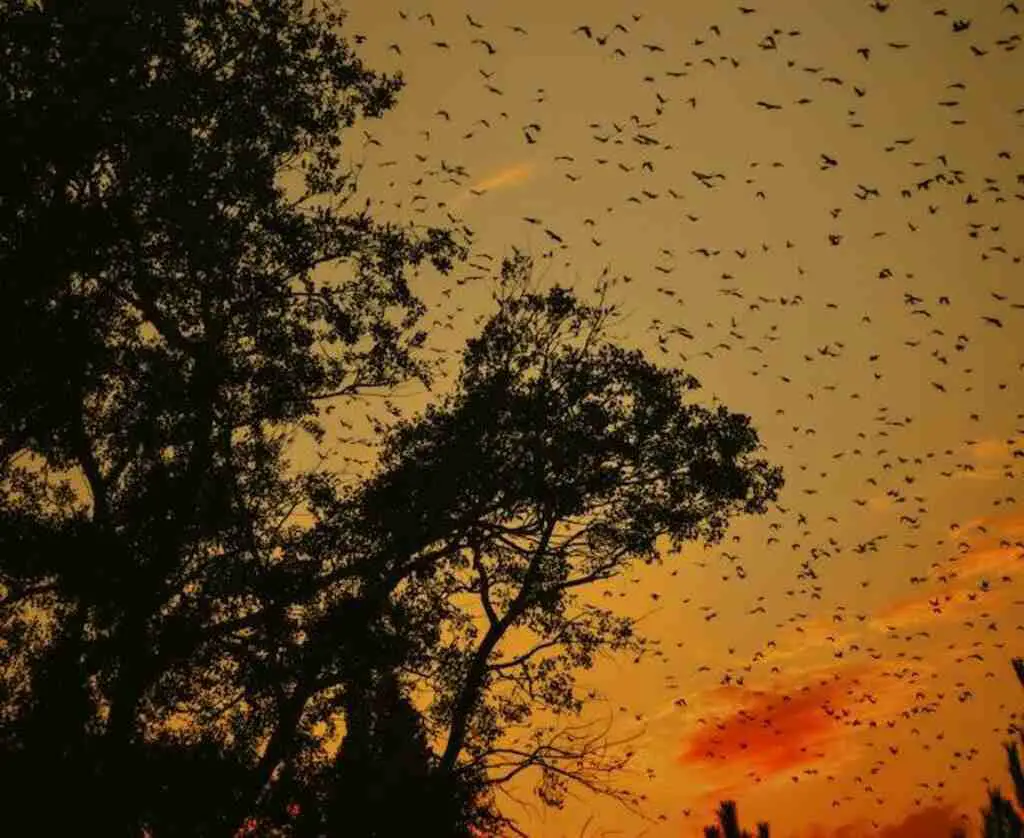
Monitoring and Research
As climate change continues to impact bird migration patterns, monitoring and research are crucial for understanding the effects of these changes on bird populations and ecosystems. Scientists and conservationists are working to collect data on migration routes, breeding habitats, and behavioral adaptations that can inform conservation strategies and policy decisions.
Some initiatives focus on tracking individual birds using GPS and radio technology, while others rely on citizen science and community-led monitoring efforts. The North American Bird Phenology Program, for example, has been collecting data on bird behavior and migration patterns for over a century, providing valuable insights into long-term changes in bird populations.
Research efforts are also focused on understanding the specific factors that influence bird migration patterns and how these factors are being impacted by climate change. For example, scientists are studying shifts in temperature and weather patterns, as well as changes in food availability and breeding habitats, to better understand the challenges faced by migrating birds.
Climate Change Mitigation and Adaptation Strategies
The impacts of climate change on bird migration are significant and far-reaching. To address these impacts, a range of strategies for mitigating and adapting to climate change have been proposed and implemented.
One essential strategy is to reduce greenhouse gas emissions, which are the primary cause of climate change. This can be achieved through a variety of measures, including transitioning to renewable energy sources, improving energy efficiency, and reducing carbon-intensive activities such as transportation and agriculture.
Another critical strategy is restoring and creating suitable habitats for birds. This involves protecting and conserving existing habitats, such as wetlands, forests, and grasslands, and restoring degraded or destroyed habitats. Creating new habitats in areas that are likely to become suitable in the future may also be necessary.
Promoting sustainable land use practices is another key strategy. This includes reducing habitat fragmentation, preserving natural corridors, and promoting biodiversity-friendly agriculture and forestry practices.
International Collaborations
Given the global nature of the issue, international collaborations are essential for effectively mitigating and adapting to the impacts of climate change on bird migration. Cooperation between countries can help to coordinate conservation efforts, share resources and best practices, and establish common goals and policies.
International agreements and initiatives, such as the Paris Agreement on climate change and the Convention on Migratory Species, provide a framework for global collaboration and action.
It is also important to support and invest in technological advancements that can assist in monitoring bird populations, tracking migration patterns, and predicting the effects of climate change on ecosystems.
In addition, partnerships between conservation organizations, government agencies, and local communities can help to mobilize resources and engage stakeholders in conservation and adaptation efforts.
Overall, mitigating and adapting to the impacts of climate change on bird migration requires a comprehensive and integrated approach that addresses both conservation and climate change mitigation and adaptation. It will require increased funding and resources, as well as ongoing collaboration and innovation.
Citizen Science and Public Engagement
Citizen science initiatives play a critical role in monitoring and conserving bird populations in the face of climate change. By involving the public in data collection, species monitoring, and habitat restoration efforts, citizen science programs provide valuable insights and help bridge the gap between scientists and the broader community.
Programs such as eBird and the Christmas Bird Count, which engage birdwatchers and other citizen scientists across the country, have yielded massive amounts of data on bird populations and migration patterns. This data is used to inform conservation efforts and guide policy decisions.
Citizen science initiatives also have important educational and awareness-raising aspects. By involving people from various backgrounds, ages and locations, these initiatives can help promote public understanding of climate change and its impacts on bird populations and ecosystems.
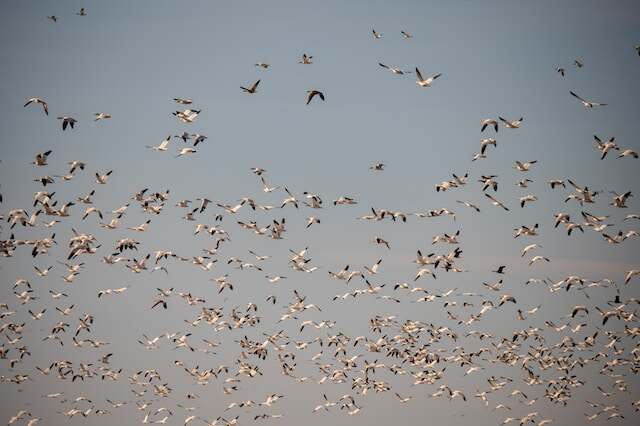
Policy Implications
Climate change and bird migration have significant policy implications that require integrated approaches to address the challenges ahead. Policymakers need to consider bird conservation goals within climate change mitigation and adaptation strategies. It is important to develop policies that reduce greenhouse gas emissions, preserve and restore habitats, and promote sustainable land use practices for bird populations and their ecosystems.
The international community also needs to focus on collective action to address the global nature of this issue. Cooperation among governments, conservation organizations, and scientific communities across the world is essential to develop effective solutions and reduce the impacts of climate change on bird migration.
Funding and Resources
The impacts of global warming on bird migration are complex and far-reaching, requiring significant funding and resources to address. While there are many initiatives and organizations dedicated to the conservation of bird habitats and populations, the scale of the challenge posed by climate change demands increased financial support and technological advancements.
One specific area that requires funding is research on the impacts of climate change on bird migration patterns and behavior. This includes tracking bird populations, migration routes, and breeding habitats, as well as monitoring climate data to better understand the specific factors affecting bird behavior. By investing in these research efforts, conservationists can gain valuable insights into how bird populations are responding to climate change and develop effective strategies for protecting their habitats and food sources.
| Initiative | Description |
|---|---|
| Conservation Funds | Funding can be used to support conservation organizations working to protect bird habitats and populations. |
| Technology Advancements | Developing new technologies (e.g. satellite tracking devices) can aid in the monitoring and understanding of bird behavior and migration patterns. |
| International Collaboration | Collaboration between countries can help to pool resources and expertise, allowing for more comprehensive research and conservation efforts. |
Governments and policymakers also play a crucial role in providing funding and resources for conservation efforts. This includes supporting national parks and protected areas, promoting sustainable land use practices, and implementing climate change mitigation and adaptation strategies. By prioritizing these initiatives, governments can help to mitigate the impacts of climate change on bird populations and their habitats.
Finally, public engagement and outreach are also important resources in combating the effects of climate change on bird migration. Citizen science initiatives and educational programs can help to raise awareness about the impacts of climate change on bird populations, and encourage public participation in conservation efforts. By working together to protect our natural world, we can ensure that bird populations and their ecosystems are able to adapt and thrive in the face of a changing climate.
Conclusion
In conclusion, the impacts of climate change on bird migration are far-reaching and complex, affecting everything from migration patterns to ecosystem interactions. As temperatures continue to rise and weather patterns become more unpredictable, it is increasingly important to understand and mitigate these impacts in order to protect vulnerable bird populations and maintain healthy ecosystems.
Conservation efforts, both at the individual and policy level, are crucial for addressing the challenges posed by climate change and supporting bird populations. Ongoing monitoring and research are also essential for building our understanding of the impacts of climate change on bird migration and informing effective conservation strategies.
International cooperation is key to mitigating the impacts of climate change on bird migration, as many of these challenges are global in nature. Citizen science and public engagement also play an important role in monitoring and conserving bird populations, as well as raising awareness about the importance of these efforts.
As we continue to face the impacts of a changing climate, it is clear that funding and resources will be essential for successful conservation and adaptation efforts. With collective action and a commitment to protecting bird populations and their habitats, we can work towards a more sustainable future for both birds and humans alike.
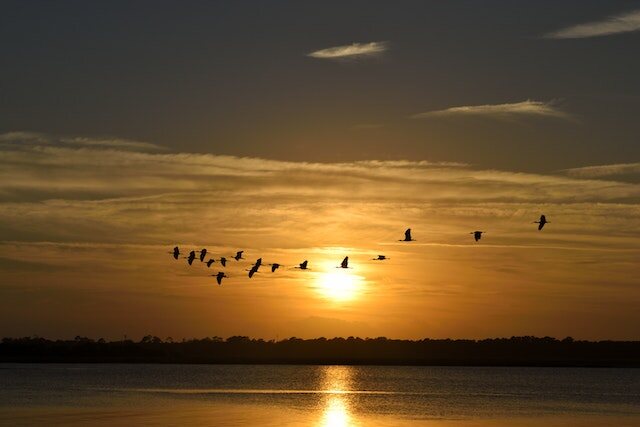
FAQs: How Climate Change Is Affecting The Migration of Birds?
How is climate change affecting the migration of birds in the United States?
Climate change is impacting the migration of birds in the United States by disrupting their traditional migration patterns. Changes in temperature, weather patterns, and food availability can affect the timing, distance, and routes of bird migrations.
What are the factors that influence bird migration patterns?
Bird migration patterns are influenced by a variety of factors, including seasonal changes, availability of food and water, breeding and nesting requirements, and environmental cues such as day length and magnetic fields. Climate change can disrupt these patterns by altering these factors.
What are the impacts of climate change on bird migration?
Climate change can have various impacts on bird migration. Changes in temperature and weather patterns can affect the timing of migration, leading to mismatches with food availability and breeding cycles. Shifts in migration routes can also disrupt ecological interactions and affect the overall functioning of ecosystems.
How are birds adapting to climate change?
Some bird species are adapting to climate change by altering their migration routes, changing their breeding patterns, or adjusting their feeding behaviors. These behavioral adaptations are crucial for the survival of bird populations in the face of changing environmental conditions.
How does climate change impact ecosystems?
Changes in bird migration patterns caused by climate change can have broader impacts on ecosystems. Disruptions to ecological interactions, such as pollination and seed dispersal, can occur, which can affect other species and the overall functioning of ecosystems.
What are the conservation efforts and challenges associated with climate change and bird migration?
Conservation efforts aimed at mitigating the impacts of climate change on bird migration are essential. However, there are various challenges in adapting conservation strategies to a changing climate. These include understanding the specific impacts on different bird species, identifying suitable habitats, and coordinating international collaborations.
Can you provide case studies of birds and climate change?
There are numerous case studies highlighting the impacts of climate change on specific bird species. These studies showcase how changing migration patterns, breeding habitats, and other climate-related factors are affecting different bird populations. They also highlight successful conservation efforts to protect these vulnerable species.
What is being done in terms of monitoring and research?
Ongoing monitoring and research efforts are focused on understanding the impacts of climate change on bird migration. Collecting data on bird populations, migration routes, and behavior is crucial for informing conservation strategies and policy decisions. Further research is needed to address gaps in our knowledge.
What are the strategies for mitigating and adapting to climate change?
To protect bird populations and their habitats, various strategies for mitigating and adapting to climate change are being implemented. These strategies include reducing greenhouse gas emissions, restoring and creating suitable habitats, and promoting sustainable land use practices. International collaborations are essential due to the global nature of the issue.
What is the role of citizen science and public engagement in bird migration and climate change?
Citizen science and public engagement play a vital role in monitoring and conserving bird populations in the face of climate change. Involving the public in data collection, species monitoring, and habitat restoration efforts is crucial. Citizen science initiatives also help raise awareness and educate communities about the impacts of climate change on bird migration.
What are the policy implications of climate change on bird migration?
The policy implications of climate change on bird migration include the need for integrated approaches that consider both conservation and climate change mitigation and adaptation. International cooperation is essential to address the challenges posed by the changing climate and protect bird populations and their habitats.
What funding and resources are available for research and conservation efforts?
Funding and resources for research, conservation, and adaptation efforts related to climate change and bird migration are available. However, increased financial support, partnerships, and technological advancements are needed to address the complex challenges posed by a changing climate.

